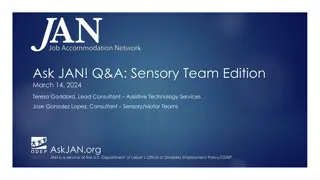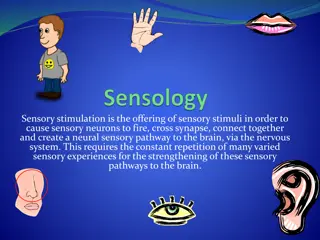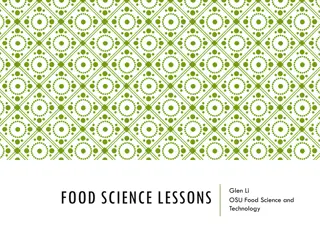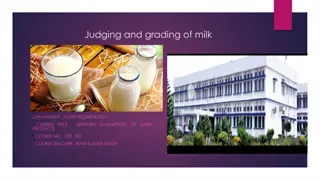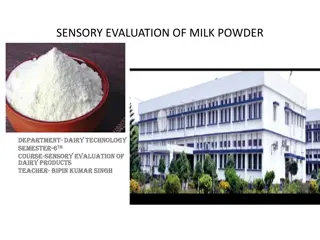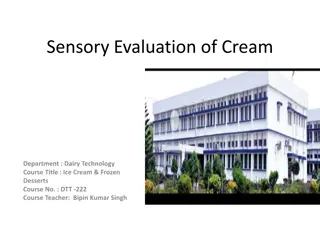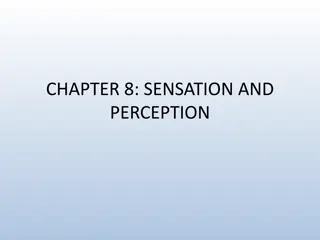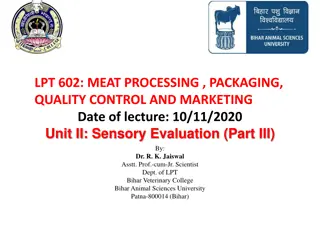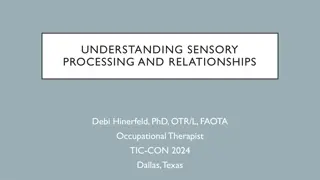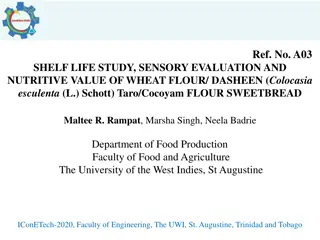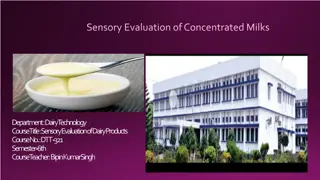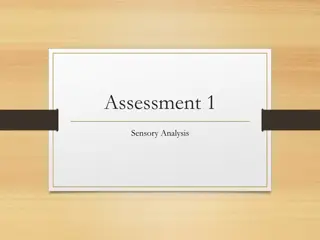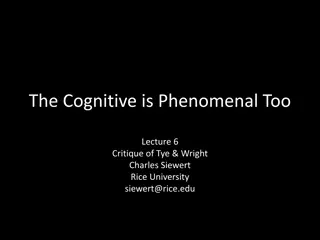Sensory Evaluation in Food Product Development
Sensory evaluation in food product development involves measuring, analyzing, and interpreting how food characteristics are perceived by the senses. This process helps in understanding organoleptic properties, conducting different types of sensory tests such as discrimination and descriptive tests, and evaluating the sensory characteristics of food through our five sensory organs. It also highlights the importance of sensory evaluation practices in improving food quality and consumer satisfaction.
Download Presentation

Please find below an Image/Link to download the presentation.
The content on the website is provided AS IS for your information and personal use only. It may not be sold, licensed, or shared on other websites without obtaining consent from the author.If you encounter any issues during the download, it is possible that the publisher has removed the file from their server.
You are allowed to download the files provided on this website for personal or commercial use, subject to the condition that they are used lawfully. All files are the property of their respective owners.
The content on the website is provided AS IS for your information and personal use only. It may not be sold, licensed, or shared on other websites without obtaining consent from the author.
E N D
Presentation Transcript
Food Product Development Sensory Evaluation
Topics Introduction Sensory Characteristics of Food Sensory Evaluation Methods Discrimination tests Descriptive tests Affective / Hedonic tests Steps / processes in carrying out sensory evaluation Good practices in sensory evaluation Steps in sensory evaluation 2
Introduction Sensory evaluation is a scientific discipline that is used to measure, analyze, evoke, and interpret the reactions to those characteristics of foods and materials as they are perceived by the senses of sight, smell, taste, touch, and hearing. Sensory evaluation involves the measurement and evaluation of the sensory properties of foods and other materials. Sensory evaluation also involves the analysis and the interpretation of the responses by the sensory professionals. Stone, H., & Sidel, J. L. (2004). Introduction to Sensory Evaluation. Sensory Evaluation Practices, 1 19. doi: 10.1016/b978-012672690-9/50005-6 4
Sensory Evaluation The characteristics of food that affect our sensory organs are called organoleptic properties Sensory evaluation means tasting food to find out what these qualities are There are three main types of tests: discrimination descriptive affective / hedonic 5
Three main types of sensory tests Is the product different or similar to a competitor s product or low-fat product? Would people notice the difference? Discrimination What does the product taste like? How does a change in production, storage and packaging affect its taste? Descriptive Affective / Hedonic How much do people like the product? Which parts do they like? Is the product an improvement to the previous one? 6
SENSORY CHARACTERISTICS OF FOOD 7
The Senses We use our five sensory organs (eyes to see, nose to smell, tongue to taste, skin to feel/touch and ears to hear) when we eat These give information about the food we eat 8
The Senses Hearing Smelling Seeing Tasting Touching Sweetness in sugar cane Mealy mashed potato Crunchy cucumber Fresh coffee Decorated cake Soft overripe peach Blue ketchup Sour gherkins Fizzy drink Stinky tofu 9
Sensory Descriptors Sense organ Characteristics Descriptors Eye Appearance (colour, texture/pattern) Golden brown, dull red, bright orange, light, dark, shiny, glowing, smooth, dull Nose Smell (aroma/odour) Burnt, acid, fishy, fruity, herby, spicy Skin Touch (texture/mouthfeel) Airy, brittle, chewy, crispy, crumbly, crunchy, dry, firm, fizzy, flaky, foamy, gritty, hard, lumpy, mushy, soggy, springy, tender, tough Temperature (hot/cold) Hot, warm, cold, sizzling hot, blazing, smoking Tongue Taste (flavour) Sweet, salty, bitter, bland, hot (spicy), sharp, stale Food type Onion, lemon, coconut, chocolate, aniseed, peppermint, garlic, meat Ear Sound Crackling, fizzing, popping, crunchy, rustling 10
Sensory Evaluation Methods Discrimination Tests - Triangle Test - Duo-Trio Test - Paired Comparison Test Are the products different? Descriptive Tests - Quantitative DescriptiveAnalysis How are they different? What is the acceptability of one product over another? Affective/Hedonic Tests - Consumer Acceptance Tests 12
Discrimination Tests Basic Question: Are two products different from one another? Basic Setup - 25-50 panellists - Screened for acuity (keenness or sharpness of perception, i.e. can they smell and taste well?) - Given triangle, duo-trio or paired comparison tests Analysis is done using tables which compare results to chance - Ensures that the difference was real and not because people chose the correct sample by luck/chance Advantage - Quick and simple Limitations - Limited results, i.e. only yes if they are different or no if they are not 13
Discrimination Tests: Triangle Test Question: Are two products different from one another? Triangle Test: Choose the sample that is most different B A A 498 746 221 14
Discrimination Tests: Duo-Trio Question: Are two products different from one another? Duo-trio Test: Choose the sample that matches the reference sample Duo Trio In front of you are two coded samples and a reference sample B. One of the coded samples is identical to the reference B. Evaluate the samples and circle the code of the sample that is IDENTICAL to the reference B. Thank you! B 221 746 15
Discrimination Tests: Paired Comparison Test Question: Are two products different from one another? Paired Comparison Test: Which sample is sweeter? 16
Discrimination Tests Triangle Test: Choose the sample that is most different Duo-trio Test: Choose the sample that matches the reference sample Paired Comparison Test: Which sample is sweeter? 17
Descriptive Tests Basic Question: How do products differ in all sensory attributes? Basic Setup - 8-12 panellists - Screened for acuity - Trained - Asked to rate intensity for all sensory attributes - Analysis is done using a t-test to determine if means are statistically different Advantages - Detailed quantitative information Limitations - Time consuming 18
Descriptive Tests Descriptive tests are used to measure the type and intensity of particular attributes of a food product The test requires panellists to describe the product in terms of its characteristics and to measure the intensity of those characteristics and to measure the intensity of those characteristics using scaling methods Most food companies have a panel that is trained on each of their products Examples of descriptive tests : - Flavour profile - Texture profile - Sensory Spectrum - Quantitative Descriptive Analysis 19
Descriptive Tests: Quantitative Descriptive Analysis (examples) Scale Line Panellists develop a list of sensory attributes before testing a product Panellists evaluate the product and mark the rate on respective lines For example, the panel would be given a sample of grape juice and they would rate the level of turbidity, colour, viscosity, etc. 20
Descriptive Tests: Quantitative Descriptive Analysis (examples) Star / Attribute Profile Panellists develop a list of sensory attributes before testing a single product or a range of products The panellists evaluate the product(s) and record the rating by plotting the data onto graphs for easy comparison among samples For example, the panel would be given samples of Sponge Cake, Madeira Cake and Genoese Sponge Cake and they would draw a star chart / diagram based on the intensity of each attribute 21
Affective / Hedonic Tests: Consumer Acceptance Tests Basic Question: Are the products liked? Basic Setup - 75-150 consumers per test - Screened for product use (Do they buy the product? And how often?) - Asked degree of liking (how much do they like it) and/or preference questions Advantages - Provides essential information Do they like it or not? Disadvantages - May be difficult to get a representative sample of consumers 22
Affective / Hedonic Tests: Consumer Acceptance Tests Used to measure how much people like a product There are several types of scales that can be used Sample Ballot Taste each product in the order listed. Circle how much you like the product. The Smiley Scale Used with children Quartermaster Corp. 9-point hedonic (liking) scale. [Most commonly used] 9 LIKE EXTREMELY 8 LIKEVERY MUCH 7 LIKE MODERATELY 6 LIKE SLIGHTLY 5 NEITHER LIKENOR DISLIKE 4 DISLIKE SLIGHTLY 3 DISLIKE MODERATELY 2 DISLIKE VERY MUCH 1 DISLIKE EXTREMELY 23
Affective / Hedonic Tests: Consumer Acceptance Tests Preference Tests The PepsiChallenge type of test that is widely used in marketing research Used to determine which product is preferred, although people have the option to choose nopreference 24
STEPS / PROCESSES IN CARRYING OUT SENSORY EVALUATION 25
Good Practices in Sensory Evaluation Facilities should be well designed White or off-white colour Lighting should be controlled There should be good ventilation 26
Good Practices in Sensory Evaluation Samples should be prepared properly Temperature should be controlled and the same for all samples Volume served should be equal for all samples Samples should be served at equivalent shelf-life or time since cooking/preparation 28
Good Practices in Sensory Evaluation Experimental Design Considerations Samples should be labelled with random 3-digit codes to avoid bias Samples should be served in random or counterbalanced order Counterbalanced order means that if 2 samples are served, half of the subjects receive one sample first and the other half receive the other sample first Counterbalancing takes into account order effects 29
Good Practices in Sensory Evaluation Carrier Usually refer to materials that form a base or vehicle for the food being tested, but may more broadly be considered as any other food that accompanies the one being tested so that they are ingested and / tasted together. Example of carriers Rice Bread Cracker Food being tested Curry sauce Butter Cheese 30
Good Practices in Sensory Evaluation Palate cleanser The goal of palate cleansers should be to aid in the removal of residual materials from previous samples Examples of palate cleansers are chocolate, pectin solution, water biscuits, warm water, water and whole milk 31
Good Practices in Sensory Evaluation Swallow or expectorated? In most analytical sensory tests, swallowing is avoided and samples are expectorated. This is assumed to provide less carry-over or unwanted influence of one product to the next. In consumer testing where acceptability is being measured, swallowing and post-ingestion effects can affect consumers opinions on the products. 32
Good Practices in Sensory Evaluation Items placed on a tray for panellists: Food samples Evaluation ballot Pen / pencil Eating utensils Napkins Carrier Palate cleanser 33
Steps in Carrying Out Sensory Evaluation Determine the purpose of sensory evaluation, and select the appropriate test. Assign three-digit random code numbers for each sample. Prepare an evaluation ballot for the panellist to fill in. Prepare samples. Serve samples to panellists for evaluation. Analyse the data. 34
References Fehners, V., Simpson, M., & Monks, B. (2011). Food technology. London: Hodder Education. Lawless, H. T., & Heymann, H. (2010). Sensory evaluation of food: principles and practices. New York: Springer. Rigewell, J. (2009). Examining Food and Nutrition for Gcse. Gardners Books. Stone, H., & Sidel, J. L. (2004). Introduction to Sensory Evaluation. Sensory Evaluation Practices, 1 19. doi: 10.1016/b978- 012672690-9/50005-6 Tull, A. (2000). Food technology to Gcse. Oxford: Oxford University Press. Woods, L. (2005). Food Technology: Gcse design & technology for Aqa. Place of publication not identified: Heinemann. 35


